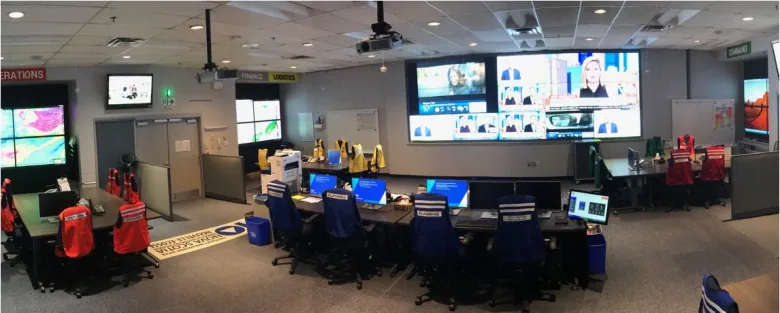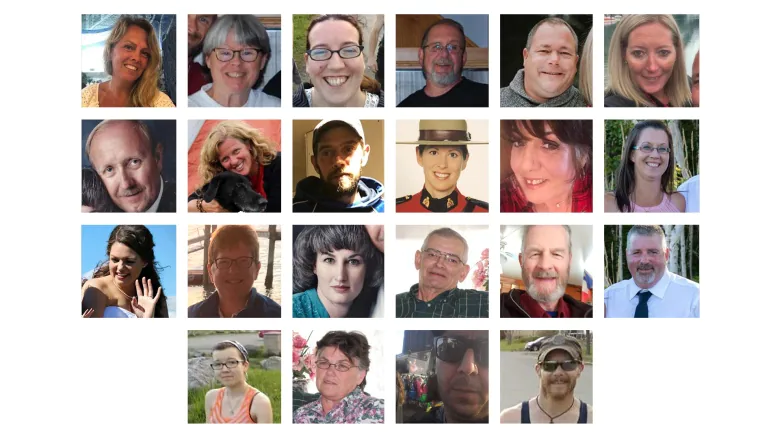New documents released by the public inquiry into Nova Scotia’s mass shootings show the RCMP had turned down the ability to directly issue emergency alerts multiple times in the years before the tragedy.
The documents also show that an active shooter situation did not meet the criteria for sending an emergency alert two years ago.
At the time of the massacre on April 18-19, 2020, all Nova Scotia police agencies had to send a request for an alert and the accompanying text to the provincial Emergency Management Office (EMO).
But the head of EMO said the office didn’t hear from the RCMP about the possibility of sending an alert until minutes before the gunman was killed. That request came after multiple attempts by EMO staff to reach the RCMP and offer the service.
The Mass Casualty Commission examining the mass shootings in which a gunman killed 22 people released new documents Tuesday reviewing the history of the Alert Ready system in the province and what happened during the tragedy.
According to the documents, the executive director of EMO told commission investigators in a February interview that while he’s immensely sympathetic to police, he’s confounded by the fact that his department wasn’t asked for an alert.
“If someone had said to me … that you would have an event go on for 13 hours where there was an extremely dangerous person who has shown that they have no qualms about killing people at random, and they’re going to roam around the province … and an alert would — nobody would think to request it of us. I wouldn’t have believed it,” said Paul Mason.
“We’ve been testing this thing for 10 years and you never even [thought] to call us?”

Nova Scotia first introduced the Alert Ready system in 2011, when it could only broadcast across participating radio stations. Ontario-based Pelmorex owns the software system and operates it on behalf of the federal government, the documents state.
“Broadcast immediate” alerts — issued in “emergency situations where life and safety are under immediate threat and time is critical, according to the documents — are now distributed via television, radio, the Weather Network app, and LTE devices such as smartphones.
Pelmorex has a governance council on public alerting that includes representatives from emergency management offices, cable and satellite companies, and radio and TV stations.
Discussions with the RCMP about having “direct access” to issue alerts without going through EMO date back to roughly 2011. Mason said the option was offered because EMO officials don’t have the situational awareness on what police are doing, and the office isn’t staffed 24/7.
Even though EMO has on-call teams that can spring into action for an alert request, its policy sets a target of sending an alert within 15 minutes, so Mason said “it takes time.”
At least one RCMP officer thought the system might be useful to police: former justice minister Mark Furey wrote a briefing note on the issue in 2012 when he was an RCMP staff sergeant.
Furey supported alert system in 2012
Furey wrote to an RCMP criminal operations support officer that such an alert system “could/would be considered an asset” to front-line police services in response to emergency situations in Nova Scotia. Nothing came of Furey’s note.
Mason offered the RCMP and regional police forces in Halifax and Cape Breton direct use of the alert system during meetings in 2016 and 2017, but they declined.
“Generally what we heard back was, ‘If we need the system for an Amber Alert or for another kind of alert, we will contact you,'” Mason said.
In a June 2016 email, Supt. Sean Auld of the Halifax Regional Police told Mason the force was declining direct access to the alert system due to concerns around “training, recertification, staffing, capacity, etc.”
Auld said a quick scan of other provinces supported that position, noting alerts were mostly sent out at the time by provincial agencies, the exception being the Edmonton police.
In 2015, the Alert Ready governing council created a list of 32 qualifying events for a “broadcast immediate” alert, including wildfires, flash flood, child abduction like an Amber Alert, or a civil emergency. The policy defined civil emergency as human activities resulting in disrupted services “or requiring varying levels of support, law enforcement or attention.”
Alert categories did not include active shooters
The EMO Alert Ready policy in November 2017 said the system should “only be used when there is an unexpected and/or rapidly building event that is dangerous and threatens the life and safety of the public. It should also be used when there is no other way to rapidly alert the public of the impending danger, due to the type, size or location of the event.”
As of May 2018, alerts could be sent to cellphones in the province using a 4G network and operating off Nova Scotia towers, and could be limited to specific geographic areas.
Rodney Legge, manager of information systems, gave a presentation about the system the following May during a Nova Scotia EMO meeting. He told the meeting the alerts are used for flooding, Amber Alerts or anything that’s imminently life-threatening.
But in the February interview with commission investigators, Mason said “civil emergencies is not for active shooters.”
He said when the 32 qualifying events were decided, active shooter events didn’t fit because “those were tactical limited local events.” Instead, Mason said civil emergencies would include things like COVID-19 or “the Washington riots and civil unrest.”
EMO ‘would have said yes’
Mason said police actions around shootings would now fall under civil emergencies, but he said “that certainly wasn’t the position” at the time of the killings in April 2020.
However, in light of what was happening with the mass shooting and how it was “not confined to a local area like an individual building … we would have said yes,” Mason said.
Nationally, Mason said the 32 codes for the alert system should still be updated.
Mason said he was shocked to learn RCMP did not have a standard operation procedure on the Alert Ready system, including step-by-step instructions on when and how to use it, at the time of the Nova Scotia shootings.
Instead of requesting an alert, the RCMP tweeted late on April 18 about a firearms complaint in Portapique. They turned to Twitter again the next day around 8 a.m. AT to report that it was an active shooter incident.
The RCMP did not release the fact that the gunman, Gabriel Wortman, was driving a mock police car until 10:17 a.m. on April 19. An image of the vehicle was posted to Twitter.

Nova Scotians immediately began asking why the Mounties chose to release information on Twitter rather than using the alert system, which would have sent information to people’s cellphones. Many have pointed out that internet service is spotty in central and northern Nova Scotia, and Twitter use is not widespread.
Family members of some of the nine people killed on April 19, 2020, have said their loved ones could have been saved had they known there was an active shooter driving a replica police cruiser on the loose.
Shortly after the shootings, Chris Leather, the chief superintendent of the Nova Scotia RCMP, said EMO contacted the force at 10:15 a.m. AT “to offer the use of a public emergency alerting system.” He said the RCMP was preparing an alert when Mounties shot and killed the gunman at a gas station in Enfield, N.S.
However, Mason told the commission that EMO was not working on a message for RCMP.
“We couldn’t get a hold of anyone,” he said.
EMO first aware of shootings on April 19
Mason said the first time he heard about anything happening in Portapique was around 8:20 a.m. AT on April 19 when EMO’s incident management director told him RCMP were responding to a shooting there and multiple buildings were on fire.
He prepared staff to be ready if an alert request came in from the Mounties, Mason said, but the only requests that came into the province were for helicopter assistance and a comfort centre.
Around 10:30 a.m. AT, Mason said he saw a photo of the gunman’s mock cruiser for the first time and asked one of his staff to contact RCMP.
That staff member had already tried to speak with the Mounties and couldn’t reach anyone, said Mason. Eventually the staff member called an officer he knew and got through that way.
At 11:20 a.m. AT, RCMP called EMO to request use of the alert system, but Mason said they did not suggest any message. Shortly after, the gunman was killed.
Halifax Regional Police and RCMP have since been trained on the Alert Ready system and are now able to issue their own alerts. Mason and Legge have said they would like to see that capability expanded to other municipal forces.
Police forces urged to take access, use other agencies
Although the other forces don’t want direct access, they also don’t want HRP or the RCMP to issue alerts for them — something Mason said he doesn’t understand.
When police reach out to EMO during off-hours, there’s a duty officer on call and not a 24/7 communications centre like the RCMP have.
“I think that’s a risk, but … I can’t tell them how to use it,” Mason said. “The police should handle the police.”
EMO has been urging Nova Scotia police forces to follow the lead of New Brunswick, where RCMP issues all alerts for police, he said.
Five days after the mass shooting, on April 24, 2020, an alert was sent out for a perceived active shooter situation in Tantallon, a Halifax-area suburb. It was the first time in the province the system had been used for that type of emergency.
In a briefing note a couple days after that alert, the RCMP said both 911 and police dispatch had been overwhelmed with 185 calls and only 131 were processed, even with an extra call taker.
They noted many callers were citizens wondering what actions they should take and looking for more information.
But Legge said besides the Tantallon situation, which happened during a time of “heightened alert,” the number of public calls after 12 police-related alerts since the mass shooting have not been “significantly overwhelming.”
Even with the Tantallon response, the dispatch system has built-in overflows where calls could be directed to another detachment or centre where call takers aren’t as busy.
“We never maxed out our system,” said Legge.
MORE TOP STORIES
Reference-www.cbc.ca